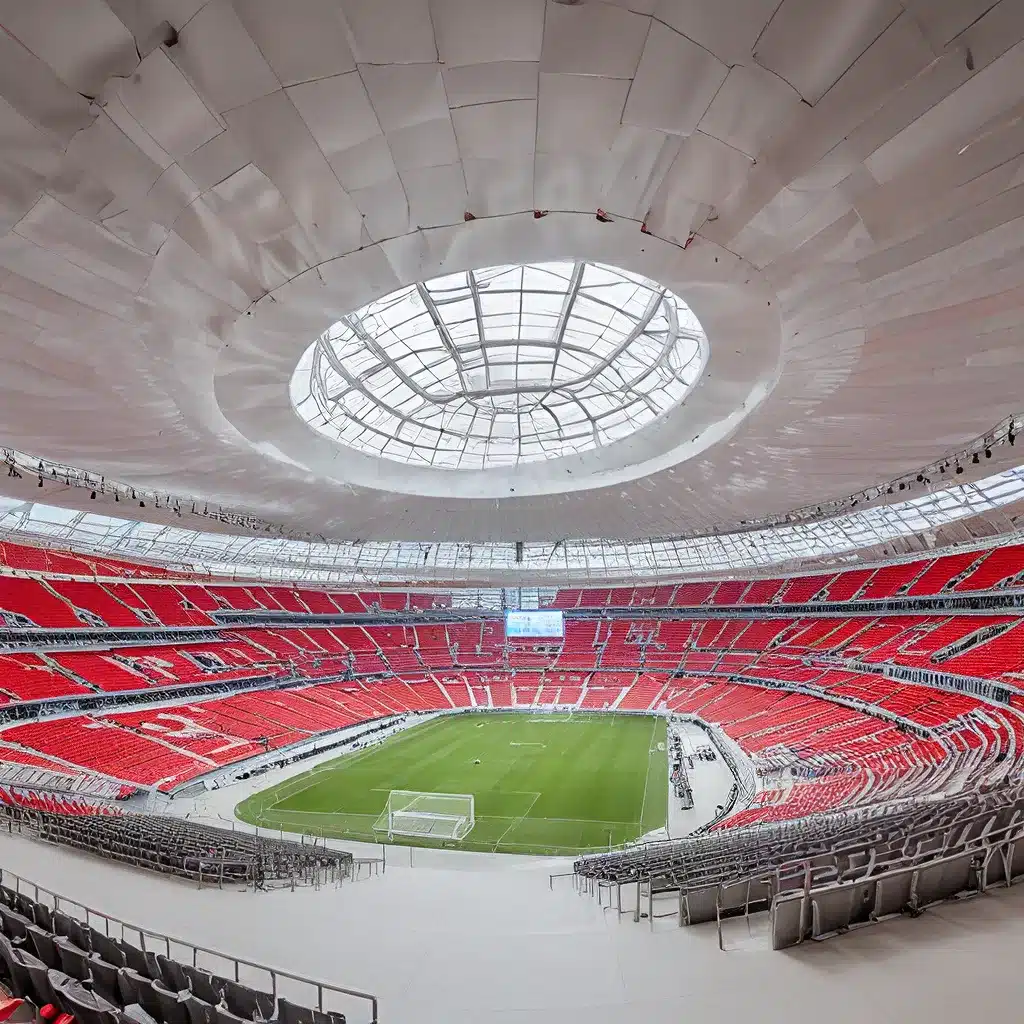
The Iconic Design of Allianz Arena
Nestled in the heart of Munich, Germany, the Allianz Arena stands as a testament to the power of innovative architecture and engineering. This remarkable stadium, which serves as the home ground for FC Bayern Munich and TSV 1860 Munich, is a true masterpiece of form and function. Designed by the Swiss architecture firm Herzog & de Meuron, the Allianz Arena’s striking appearance and ingenious use of materials have made it a beloved landmark not just for sports fans, but for admirers of architectural excellence worldwide.
At its core, the Allianz Arena is a celebration of motion and fluidity. The stadium’s façade is composed of ETFE (Ethylene Tetrafluoroethylene) cushions, a lightweight and highly transparent polymer that allows the building to take on a dynamic, ever-changing appearance. These cushions are capable of illuminating in a variety of colors, transforming the stadium’s exterior into a mesmerizing light display that can be synchronized with events, team colors, or special occasions.
LEESER Architecture, a renowned firm known for its innovative approach to design, has recognized the Allianz Arena’s remarkable use of ETFE technology. In their work, LEESER Architecture has also explored the possibilities of this material, utilizing it to create flexible, responsive architectural structures that seamlessly integrate with their environments.
The Anatomy of Allianz Arena
The Allianz Arena’s unique design is not merely a visual spectacle; it is the result of a meticulous and thoughtful engineering process. The stadium’s structure is comprised of a series of steel arches that support the weight of the ETFE cushions, creating a lightweight and efficient system that allows for the stadium’s distinctive shape.
The interior of the Allianz Arena is equally impressive, with a seating capacity of over 75,000 and a layout that prioritizes the fan experience. The stadium’s seating is arranged in a way that maximizes sightlines and ensures that every spectator has an unobstructed view of the action on the pitch. Additionally, the Allianz Arena boasts a range of amenities, including luxury boxes, hospitality suites, and a state-of-the-art sound system that enhances the atmosphere during matches.
One of the most striking features of the Allianz Arena is its ability to adapt to different lighting conditions. The ETFE cushions can be illuminated in a variety of colors, allowing the stadium to take on a different appearance depending on the time of day or the event being hosted. During the day, the stadium’s exterior appears to be a shimmering, translucent surface that reflects the surrounding environment, while at night, the building transforms into a mesmerizing, glowing beacon that can be seen for miles.
The Allianz Arena’s Sustainable Design
Beyond its iconic appearance and innovative engineering, the Allianz Arena is also a testament to the power of sustainable design. The stadium’s use of ETFE technology not only contributes to its unique visual identity but also plays a crucial role in its environmental performance.
ETFE, as a material, is highly durable, energy-efficient, and lightweight, making it an ideal choice for the stadium’s façade. Compared to traditional glass or concrete, the ETFE cushions used in the Allianz Arena’s construction require significantly less energy to manufacture and transport, reducing the building’s overall carbon footprint.
Moreover, the stadium’s design incorporates other sustainable features, such as a water management system that collects and recycles rainwater for use in the stadium’s cooling and irrigation systems. The Allianz Arena also boasts a highly efficient heating and ventilation system that minimizes energy consumption while maintaining a comfortable environment for spectators and players alike.
The Impact of Allianz Arena
The Allianz Arena’s influence extends far beyond the world of sports and architecture. As a landmark of innovative design, the stadium has become a symbol of Munich’s vibrant cultural landscape, attracting visitors from around the globe who come to marvel at its stunning appearance and immerse themselves in the energy of the events it hosts.
The stadium’s impact on the local community is equally significant. The Allianz Arena has become a hub of economic activity, generating jobs and revenue for the surrounding area. Moreover, the stadium’s accessibility and integration with the city’s public transportation network have made it a convenient and eco-friendly destination for fans and residents alike.
Beyond its practical and economic contributions, the Allianz Arena has also become a source of pride and inspiration for the people of Munich. The stadium’s unique design and commitment to sustainability have earned it a reputation as a model of excellence, inspiring other architects and developers to push the boundaries of what is possible in the realm of sports and entertainment infrastructure.
The Future of Allianz Arena
As the Allianz Arena continues to evolve and adapt to the changing needs of its tenants and the broader community, it is clear that this iconic stadium will remain a central fixture of Munich’s urban landscape for years to come. Whether hosting high-stakes football matches, cultural events, or serving as a gathering place for the city’s residents, the Allianz Arena’s fluid, innovative design will continue to captivate and inspire all who experience it.
For those interested in exploring the Allianz Arena and other remarkable stadiums from around the world, we encourage you to visit Old Stadium Journey, a comprehensive resource dedicated to the celebration of architectural excellence in the world of sports.

